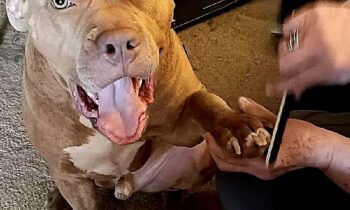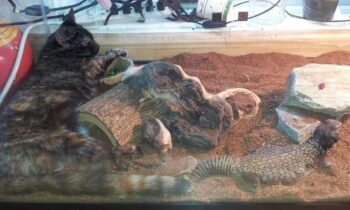
Laura Bourhenne is a professional dog and pig trainer who lives in the Los Angeles area. Recently, she’s been sharing stories, photos, and videos with her online friends about her newest family member. His name is Fidget and he already has his own Instagram account. He’s a pig.
I asked Laura to talk with us about pigs, pig training, and pigs as pets.
Laura, tell us about your background in animal training.
In 1987, I had the privilege of attending Moorpark College’s Exotic Animal Training and Management program. It is a two-year program focused on the care, training, handling, and management of exotic animals. The program began in the 1970s when the only animal they had to care for and learn from was a single wolf. The program and compound has changed quite a lot since I graduated. It’s now called America’s Teaching Zoo, though the program is still called the EATM Program and has well over 700 animals. During my two years at EATM, I trained birds of prey, primates, and domestic animals, earning an Associate of Science degree in 1989.
How the heck did you ever get into pig training?
Shortly after [my] graduation, the compound received a call from a family in Santa Monica who had a potbelly pig they needed help with. The office at EATM referred them to me and that’s where it all began!
I understand you do pig-training consults via the internet as well as in-person visits for pigs and owners who live near you. How does a web training session work?
As with all my clients, a history form is filled out prior to the appointment so I can see what the specific issues are and put together a plan on how best to spend our training time. It works best if the client is able to use a laptop so they can move around and show me the pig’s living space, but if the camera is stationary that will work fine.
During the session I gather a little more info about the specific issues and demonstrate exercises the pig should learn, as well as discuss management if aggression is an issue. The session is recorded and when we are finished, I send a link so the client can download the session for future reference. I also send written instructions and links to other videos regarding the exercises we went over.

Photo by Laura Bourhenne
What are the most common problems that novice pig owners have with their pigs?
Pushiness, squealing, and aggression.
How have these problems come about?
If someone has had their pig since it was tiny, the problems probably started then but weren’t noticed until the pig got bigger. Pigs are pushy by nature—it’s how they find food and survive. Unfortunately, when they are small, we don’t pay much attention to the behavior because they are small, not realizing that in the future, these will become big problem behaviors. Plus, people think many of the behaviors are cute when the pig is small. They don’t envision what the same behavior will look like when their piglet weights well over 150 pounds.
What suggestions do you make about solutions to pig problems?
Teaching the pig impulse control, patience, and other behaviors to do that will pay off for them.
What should prospective pig owners know about pigs?
That they are very, very smart. They get into everything and can be pretty destructive. But they are clean, easy to housetrain, and a ton of fun.
What kinds of pigs are most popular?
Most people think of potbelly pigs when they think of pet pigs, but there are also Juliana pigs and a few other hybrids people have come up with.
Where’s the best place to look for a pet pig?
The best place to look is in the shelter or at rescues. So many pigs are turned in to shelters and rescues because people get them not knowing what to expect, and are lied to by breeders about how big the pig will ultimately be, what living with a pig is really like, and how to meet their needs.
How do you know you’ve found a responsible pig breeder?
When you can see the conditions in which the piglet was born and they are clean and the piglet has been socialized until the time you pick them up. When you know the true age of the parents. Pigs don’t reach full size until they are around three-plus years old. So if the breeder tells you your piglet won’t get any bigger than the parents, but the parents are only seven months old, run away as fast as you can.
How old a pig should you adopt?
Adopting a pig at any age is great, but as young as six weeks old is fine.
Any differences between male and female pigs that we should know about?
In my training experience, I find the male pigs with issues easier to deal with. They tend to go with the flow more than the females. The females are a bit more difficult to convince that things are going to change.
What’s pig health care like? Are they spayed/neutered? Is their vet care expensive?
Having them spayed/neutered before ten or twelve weeks old is best because their hormones kick in and they can start doing some pretty hormone-based aggressive behaviors. Their health care is straightforward, but they will pick up anything that looks edible—and some things that aren’t—so care must be taken not to leave things lying around that could hurt them (electrical cords included!). It depends on where you live and how much you do on your own; for example, trimming their hooves. Some people take their pig to the vet or have a vet come to them for hoof and tusk trims, but you can also train your pig to allow you to trim their hooves.
Can pigs be covered by pet insurance?
There is at least one insurance company that will cover pet pigs, but it’s not one of the more common pet insurance companies.
What sort of space and “housing” is needed for a pet pig?
I prefer pigs to be house pets, but plenty of people keep them outside. They like companionship and shouldn’t be alone, so if they are kept outside, they should have a friend—another pig or farm animal is good.
What do pet pigs eat?
Anything and everything! In general, pig pellets, vegetables, fruits, and grains. There are lists online of what they can and cannot have. There are things that are bad for them, so it’s best to check your pig’s living area thoroughly and be sure to put baby locks on cabinets so they can’t get into toxic cleaning materials, etc. Even if you think they can’t open something, they probably can, so it’s best to be preventive.
What sort of training or handling does not work well for pigs?
Force and punishment don’t work well with pigs because they remember everything. That can really backfire on you and destroy the trust and relationship you are trying to build.
What sort of training or handling does work well for pigs?
Reward-based training works wonders since they are so intelligent and food-motivated. They also like to be scratched on their sides.
Pigs don’t see very well and are easily startled, so positive introductions to new people and situations are a must. Don’t force the issue if your pig is scared; give them time to assess new situations and approach strangers on their own time.
What basics should “every pig” know?
Come when called, load into a vehicle, crate training, be okay with being picked up, hold still while being harnessed, how to walk on a leash. Target training is very handy when in a new environment because it can be used to move a pig from A to B even if the pig is nervous. They should know not to be pushy around food, and that being pushy does not get them what they want.
Personally, I like my pig to think everyone in the world knows the rules he lives by and that he can’t be pushy with anyone. And I think all pigs should know that people are good and not to be frightened of them.
Training A Pig To Wear A Harness—video by Laura Bourhenne:
https://www.youtube.com/watch?v=fk0d0N77pMM
To contact Laura Bourhenne: www.pigtrainer.com
Fidget’s Instagram account: https://www.instagram.com/fidgetthepiglet/



